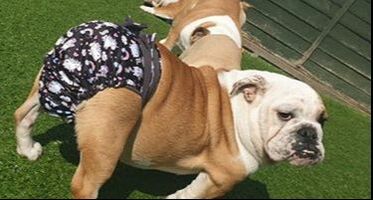 Poppy in her knickers Poppy in her knickers Let me tell you about the little scare I had a few days ago. My youngest dog Poppy ‘the puppy’ she has had a really rough time with her first season at 9 months old. To be blunt the bleeding was horrendous and I decided after over 30 years of living with 'breeding girls' to buy some ‘dog knickers’, they are pretty cute I must admit! One pair of unicorns and one pair black floral knickers with 14 washable sanitary towels set me back over £50! They did the job to a degree but she kept peeing in them too as she had also picked up a spot of cystitis and also the odd poo! After what seemed to be eternity she was ‘drying up’, but the next day we had constant ‘strawberry milkshake’ discharge, I knew this meant only one thing, Pyo. Pyometra is a uterus infection that can be deadly. It’s really unusual for dog to get Pyo with their first season, but I knew it possible. I was fortunate that I could quickly ultrasound scan her and see pockets of puss. I was even more lucky that the vets could fit me in less than an hour. Spaying is typically the first option, but given she was so young and still growing and kept to continue my bloodline I decided to take an alternative option. This meant two Alizin injections 24 hours apart altering the uterus lining and long course of antibiotics, with a 3rd injection to be given 7 days after the first. It seems a major disaster has been avoided! This is because I followed my OATH framework for identifying problems and making sure I deal with them effectively. So what does OATH standard for?
I then observed the ‘strawberry milkshake’ discharge, that she was drinking more, quieter and lethargic. Acknowledging this wasn’t typical and took action to scan her and making an appoint ASAP for additional medical help, the last part of the framework. This framework is a perfect framework to follow as a pet owner to help you clearly identify issues and potential issue and whether you act removing unnecessary stress. |
Categories
All
AuthorWritten exclusively by Sara, a proud founder of the LaRoyal name and a seasoned bulldog enthusiast, our blogs are overflowing with an abundance of show wins, captivating ideas, and a plethora of thoughts and feelings. We are thrilled to embark on this journey, sharing our "real-life" dog ownership experiences with you, our valued readers. Archives
July 2024
|
In summary ...We have lived with the breed for nearly 30 years, during this time we were introduced to the 'show scene' and have never looked back! We have been fortunate to win over 25 CC's to date and have been awarded the highest of accolades with home-bred dogs including Best of Breed at Crufts 2013.
|
Popular pages ... |
This website and its content is copyright of LaRoyal Bulldogs™ © 1999 - Present. All rights reserved
 RSS Feed
RSS Feed
